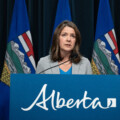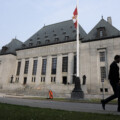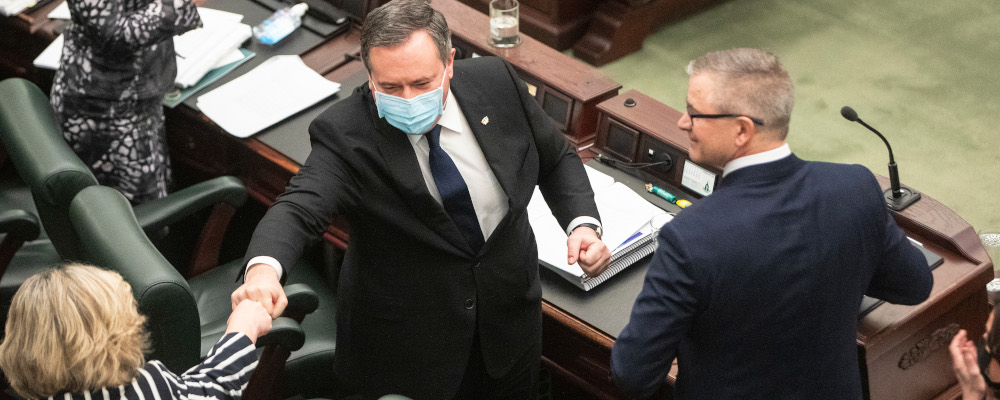In Alberta’s latest budget, we learned the province’s resource revenues exceeded $13 billion last year and may approach $14 billion this coming year (even with conservative assumptions).
Combined with lower per capita spending, this opens the door to fiscal possibilities few Albertans might have thought possible.
With some good luck, a debt-free Alberta by 2030 is one.
Perhaps not likely, but possible. (And recently advocated for in a recent column by my University of Calgary colleague Jack Mintz.
Even more tantalizing is the possibility of finally easing the province off its risky reliance on oil and gas revenues.
Neither outcome is preordained. But modest, disciplined, and sustained fiscal policy adjustments could achieve both. I’ll explain.
Of course, so much depends on the price of oil. I’ll present a scenario that helps mitigate that risk. But whatever one thinks about the likelihood of any of this, the mere fact that it’s plausible is remarkable and worth thinking about.
Pay down debt? Or save?
Alberta’s Budget 2022 projected surpluses for the next three years.
The budget also contained an interesting nugget that received little attention: “Any surplus up to the value of the annual earnings of the Heritage Savings Trust Fund will be retained and re-invested in the fund,” it read.
It goes on to say, “any surplus in excess of those savings will be allocated between the Heritage Savings Trust Fund and/or debt repayment.” (Italics added.)
Which to choose: pay down debt or save?
Individuals face this choice regularly. Pay down your mortgage or contribute to your RRSP?
For Alberta, the choice is relatively simple. It depends on what we expect to earn from Heritage Fund investments versus the government’s own borrowing costs. Over the past decade, the Fund earned an 8.9 percent annual return (net of fees) while interest costs were typically between 3 to 4 percent.
So a dollar in debt repayment saves three to four cents while a dollar saved earns much more on average. We should therefore save, at least while interest rates remain low. This lowers a government’s net debt rather than gross debt. So I’ll focus on that.
Debt free by 2030?
What would it take to achieve zero net debt by 2030? To answer this question, I use my own detailed model of Alberta’s long-run finances (details available here and here) and incorporate the latest projections from the budget and other sources.
Two ingredients work.
First, spending grows no faster than population plus inflation.
Second, new revenues of approximately $5.5 billion (starting 2023), increasing with Alberta’s economy thereafter. It doesn’t matter what revenues. A sales tax of 5 percent could do it. Unexpected increases in resource revenues by 50 percent could as well. I illustrate both below where the “baseline” projection includes only the spending restraint.
A 50 percent increase in projected resource revenues may sound crazy. It’s not. The budget is based on oil prices of $70 per barrel this coming year, declining to less than $67 by 2024. Markets currently expect higher prices, perhaps into the mid-$80s—more than enough for what’s needed here.
Neither spending restraint nor new/higher revenues are easy or risk free. Higher resource revenues are obviously not something Alberta can directly control. And if resource revenues decline substantially, then net debt rises (in an unsustainable way, as illustrated above) even if spending is restrained to population growth plus inflation.
Could Alberta eliminate its provincial debt while simultaneously relying less on resource revenues? Surprisingly, the answer appears to also be yes.
The Prentice Plan 2.0
In 2015, former Premier Jim Prentice attempted to gradually save 50 percent of resource revenues. This would serve as a buffer against price drops while the other half would go towards the main budget.
Saving 50 percent isn’t an arbitrary threshold. Resource revenues are definitely volatile, but extreme drops are relatively rare. Over the past half-century, for example, only five years saw these revenues drop by more than 40 percent and only two years saw declines of more than 50 percent. That’s a once-in-a-generation event, making a 50 percent threshold natural.
Of course, saving resource revenues creates a hole that needs filling. To make up the difference, he proposed significant spending restraint (and outright reductions in health) along with new taxes that were set to raise nearly $2.7 billion by 2018.
What would a “Prentice Plan 2.0” look like today?
I illustrate below (1) new taxes to raise approximately $3.3 billion in 2023 (similar size as the original Prentice plan, projected forward, and achieved through a health contribution payroll tax like in BC and other modest changes); (2) a rule to save 50 percent of resource revenues (earning 8 percent annually); and (3) spending grows with inflation and population.
This is an encouraging result.
If energy prices and production perform as forecast (by Alberta and by the federal regulator), then the province may achieve zero net debt within roughly a decade. And if resource revenues disappoint, the consequences will be significantly dampened since only half of resource revenues were ever counted on anyway!
What if global oil demand wanes?
This is an important question.
A reasonable place to understand how this might affect oil prices is the projection from Canada’s national energy regulator in its latest Energy Future Report. Their baseline projection has prices of $66 per barrel from 2024 onwards (in 2020 dollars). Interestingly, this is roughly in line with the later years of Alberta’s 2022 budget. But in their “evolving scenario”, which features increasingly stringent policies to lower greenhouse gas emissions, they project prices below $50 per barrel by 2030 and barely $40 by 2040 (both in 2020 prices).
Will such a scenario doom Alberta’s finances? Not necessarily.
Keeping the growth of total government spending to no more than population growth plus inflation goes a long way to ensure Alberta’s finances are sustainable, even in the face of increasingly stringent global action on climate. I illustrate that below, with the range reflecting current policies versus the regulator’s evolving scenario.
This isn’t to say taxes should or shouldn’t increase. But any increase in spending above and beyond that of population and inflation should come with a corresponding tax increase to fund it.
This may also be a “fiscal anchor” that crosses party lines. The previous NDP government, for example, was committed to it. Their spending above population plus inflation was instead funded through increased taxes (such as the carbon tax-funded environmental initiatives).
Spending restraint alone ensures sustainability, but it neither achieves zero debt by 2030 nor stable finances that do not rely on resource revenues. For that, we need more.
Many options for Alberta
Alberta is lucky to have a wide variety of potential routes forward, and much more serious thought should be paid to exploring them. Successive governments have put off this difficult task, but they should no longer.
The Prentice Plan 2.0 achieves a debt-free target within roughly a decade. But it also allows for spending growth to alternatively exceed inflation plus population growth. As populations age, this may be unavoidable—the strain on the health-care system might just be too much.
Whatever your policy objectives, a stable and secure financial future is needed.
Now is the time for Alberta to finally start to seriously and openly consider options to do just that.
Recommended for You

Karen Restoule: Trust, not speed—If Ottawa wants major projects built, it must let Indigenous leaders and industry set the terms

Catharine Kavanagh: What to do if the looming Alberta teacher strike actually happens

Tim Sargent: Letter to a minister: How to protect the environment and support economic growth at the same time

‘No Charter without section 33’: How six provinces are defending the notwithstanding clause




